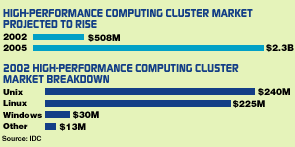New Formula For Supercomputing
Companies that solve data-intensive computing problems are no longer limited to purchasing only expensive, custom-built supercomputers from Cray or IBM. Now they can go to solution providers to buy inexpensive Linux server clusters built from commodity computer parts.

\
Linux NetworX CEO Steve Hill says scientists were 'banging on the door for months' to use the 1,152-server Linux cluster that his firm sold to the Lawrence Livermore National Laboratory in California.
Take Linux NetworX. CEO Steve Hill said the Sandy, Utah-based integrator recently sold a cluster of 1,152 Intel Xeon-based servers (a total of 2,304 processors) to Lawrence Livermore National Laboratory in Livermore, Calif., which plans to use the system for scientific research and simulations. Now scientists from other labs are clamoring to use Livermore's cluster.
"The Livermore lab has had scientists from within the lab banging on their door for months, asking, 'When will it be ready [for us to use?' " Hill said. The buzz has swayed other scientists and computing-hungry end users to consider getting their own Linux clusters, and Linux NetworX followed the Livermore contract with the sale of a similar sized cluster to Los Alamos National Laboratory in New Mexico, he said.
"The cluster we designed for the Livermore lab will demonstrate the capabilities of clustering, its robustness and its suitability for the toughest applications out there," Hill said. "This system will be a milestone in computing history."
Indeed, Linux NetworX and a handful of other solution providers,including firms such as PCPC, Houston; Atipa Technologies, Lawrence, Kan.; and the Cornell Theory Center (CTC), an Ithaca, N.Y.-based lab-turned-integrator,report that interest in Linux clusters is surging. And with the technology taking hold or drawing attention in markets such as scientific research, biotech, manufacturing, pharmaceuticals, energy, academia, government, aerospace, financial services and professional video/multimedia, the opportunities for the channel stand to multiply.
Solution providers can delve into the high-performance computing Linux clustering market on different levels, depending on their expertise and interest. On a basic level, they can assist vendors in the staging and support of server clusters or by providing additional services and applications. And on a more active level, solution providers can build entire clusters from scratch or procure complete clusters from vendors and then customize the hardware with software tailored to the customer's needs. Whichever path a solution provider takes, a menagerie of vendors,including Intel, IBM, Oracle and Myricom,offer a range of support, such as in-depth training, marketing assistance and technical support.

\
'The cluster we designed for The Livermore Lab will demonstrate the capabilities of clustering, its robustness and its suitability for the toughest applications out there. This system will be a milestone in computing history.' --Steve Hill, Linux NetworX
"The shift to high-volume standard components has created new opportunities for channel integrators in high-performance computing that were not possible even three years ago," said Rick Herrmann, manager of the high-performance computing practice at Intel, which sells clusters exclusively through solution providers.
The use of clusters for high-performance computing applications began in the mid-1990s, when researchers at government labs began linking groups of commodity servers with fast interconnects and shared memory and running them on the open-source Linux operating system, achieving supercomputer-level performance at a much lower price. Their success quickly spread the technology into mainstream computing markets and the IT channel.
"The price-performance is 10 to 15 times [that of a supercomputer, and it's not uncommon to find someone who moved an application from Unix to Linux and got 20 times the price-performance," said Bill Claybrook, an analyst at the research firm Aberdeen Group.
For example, the 1,152-unit Linux server cluster that Linux NetworX built for the Livermore lab cost about $15 million, compared with $100 million for the IBM ASCI White,one of the world's most powerful supercomputers,already in use at the facility, according to the lab and the solution provider. Both high-performance computing systems reach a peak computing performance of 12 teraflops, or 12 trillion calculations per second.
"To be competitive from a scientific point of view, one needs good theory and a good experimental program. But one also needs world-class scientific simulation capability, which means large clusters," said Dr. Mark Seager, assistant department head for terascale systems at the Livermore lab. "We want to be an early adopter at a large scale to take advantage of the cost savings. The open-source commodity market is a very powerful technology curve to be on."

Because of the hefty price savings offered by Linux clusters, the Aberdeen Group last year predicted that the technology would account for 80 percent of the high-performance computing market within three years. Likewise, research firm IDC projects the high-performance computing cluster market will climb to $2.3 billion in 2005, up from $508 million this year. Unix clusters are slated to represent $240 million of the 2002 high-performance computing cluster market, followed by Linux ($225 million) and Windows ($30 million), IDC reported.
Since their early experiments with clusters, government and academic research labs have been the chief adopters of Linux clusters and remain a key focus of Linux NetworX, Hill said. "The Livermore lab saw us as having the commitment to being a leader in supercomputing technology, especially in high-performance computing clusters," he said, adding that Linux NetworX has built such clusters for clients in the research, manufacturing and biotech/pharmaceutical spaces.
The latter market, in particular, is embracing Linux clustering for supercomputing applications, industry observers say. Biotech/pharmaceutical companies are leveraging the power and data storage capabilities of clusters for advanced chemical and genome research, data mining and drug design, and they report that clusters significantly cut the costs of drug development.
For instance, Linux NetworX recently sold a 75-server Linux cluster to Tularik, a San Francisco biotech firm. Dr. Bruce Ling, director of bioinformatics at Tularik, said his company had considered purchasing a traditional supercomputer but opted for a Linux cluster when it realized that it could get greater computing power for the same price. "In the pharmaceutical business, information becomes extremely critical. You need to dedicate a lot of resources, and clusters are a cheap way to handle the information." Ling said, adding that Tularik surveyed various solution providers before deciding to buy its cluster from Linux NetworX.
"Companies selling Linux clusters need to know Linux by gut. You need good personnel, good support," he said. "We put all the Linux [clustering providers side by side [and compared cost and support. Linux NetworX knows what they're doing."

\
ATTRACTING A FOLLOWING
\
Last year, research, firm Aberdeen Group predicted that Linux clusters would dominate 80 percent of the high-performance computing space within three years. Here are some markets where Linux clustering is catching on or drawing interest:
Academia
Aerospace
Biotech
Energy
Financial services
Government
Manufacturing
Pharmaceutical
Pro video/multimedia
Scientific research
Another solution provider that knows what it's doing in the Linux clustering realm is PCPC. Between 1999 and 2001, the Houston-based firm boosted its sales 628 percent, from $620,000 to $4.5 million, in large measure by selling Linux clusters to petrochemical companies.
"The petroleum industry has been our main focus," said Joe Vaught, executive vice president and COO of PCPC. "Petrochemical companies use Linux cluster power for reservoir simulations and sounding, and they save a lot of money by getting off their expensive supercomputer leases and going to the Linux platform. Oil companies need Linux clusters regardless of where the market is going."
PCPC has built Linux clusters for such oil industry titans as Texaco, Chevron and Philips Petroleum, according to Vaught. The experience from those projects, he said, has led PCPC to expand its Linux clustering solutions to the manufacturing and high-tech sectors, where companies use the technology for automobile crash-test simulations, materials research and product/system design.
"We received a $1.8 million order from Lockheed Martin and expect several from Texas Instruments," Vaught said. "We're already up to our third or fourth cluster with TI, but I think it's just the tip of the iceberg. TI is getting on the Linux cluster bandwagon big time."
High-performance computing Linux clustering solutions have become PCPC's key business driver, Vaught noted. "Three years ago, we were selling more laptops than anything else, but now it's just one cluster after another," he said. "Often we'll install a cluster, and a week later we'll get a request for another one from the same company. Linux clusters have really helped us to maintain tremendous growth in a down economy."
Vaught credited much of PCPC's success in the Linux clustering arena to the support it receives from IBM, which provides PCPC with hardware and software plus the training and support it needs to close deals. "I waved the Compaq flag for years. But now the blue hat is on, and I'll probably die wearing it," he said. "The fact that IBM spends so much money on clusters made us feel really good about getting into it."
IBM sells clustering technology via channel partners and direct to customers, said David Turek, vice president of Linux clusters at the vendor. "PCPC is a good example of a channel partner. They're more sophisticated than just a standard reseller," Turek said. "Our business partners play a useful role by refining and crafting solutions on top of the cluster technology that we provide."
While many clusters are sold directly to end users, channel partners play an important role by shaping the high-performance computing solution, Vaught said. "We provide the customization and understanding that end users need," he said.
Bret Stouder, director at integrator Atipa Technologies, said his firm sells Linux clusters to academic and government research labs and Fortune 500 companies but is seeing a rising need for clustering in manufacturing, especially the aerospace industry.
"Anyplace that's using mainframes, we'll be there," Stouder said. "Companies like Honeywell and Lockheed Martin are keen on using cluster technology. Boeing is already using clusters for its airplane design. Airlines are using rooms of IBM mainframes for ticketing. But with the [high price for maintenance every year, we can easily give them five to 10 times the processing power and simplify the process."
Any industry that needs to process a high amount of data or complex information is a prime target for high-performance computing clusters, Intel's Herrmann said, citing the financial services space. "There is a lot of need for clusters in the financial vertical. You have risk analysis, options pricing, derivatives modeling, etc.," he said.
CTC, for one, is zeroing in on potential financial services customers. The research lab has been working with Microsoft and other partners to develop clustering solutions for financial institutions and recently established an office in Manhattan's financial district to sell the solutions, said Thomas Coleman, CTC director. "We've seen for a long time that there would be significant potential for a market here," Coleman said. "The financial industry and banks are very interested, especially in the [Microsoft .Net environment. You can do serious computations in that environment."
Once CTC establishes itself in financial services, it plans to branch out into the oil and manufacturing industries, Coleman added. "CTC is targeting two potential groups of customers: current high-performance computing users, who may be interested because [clustering is more cost-effective, and people who are currently solving data-intensive problems on their desktops and could use cluster solutions to solve their problems," he said. "These are people who don't know about the technology, but when shown the possibilities, will use it."
The breadth of potential customers for high-performance computing Linux clusters paints a bright picture for solution providers willing to take the plunge, PCPC's Vaught said. "A company our size can easily do $100 million in sales," he said. "In a couple of years, everyone will be doing this."